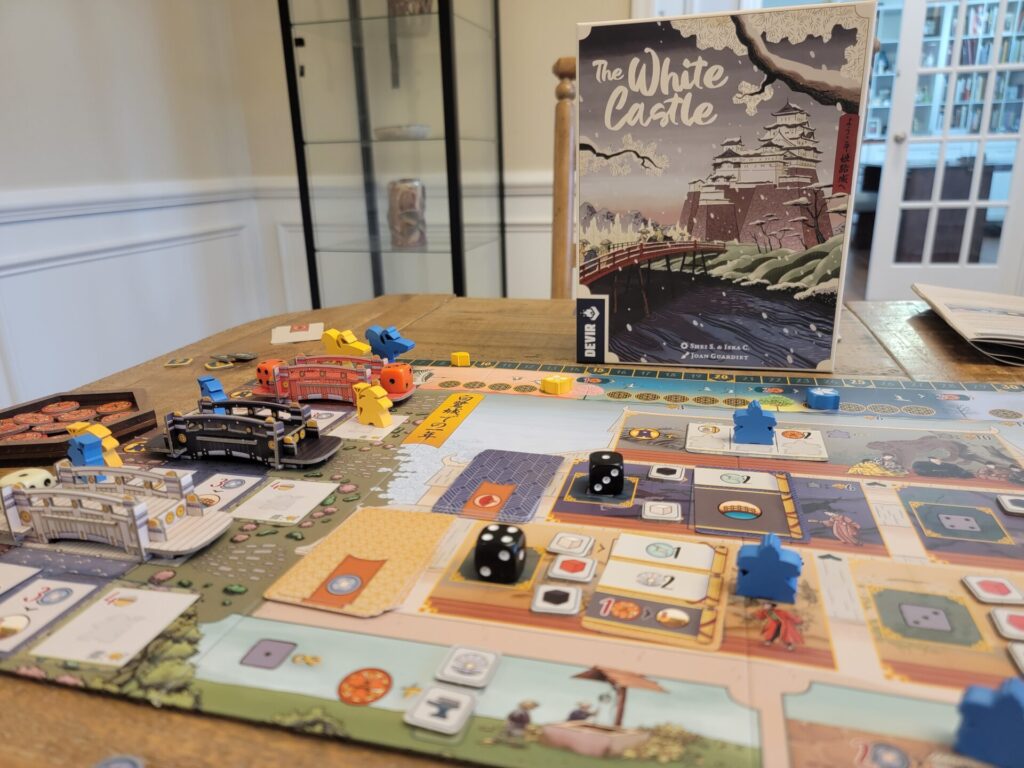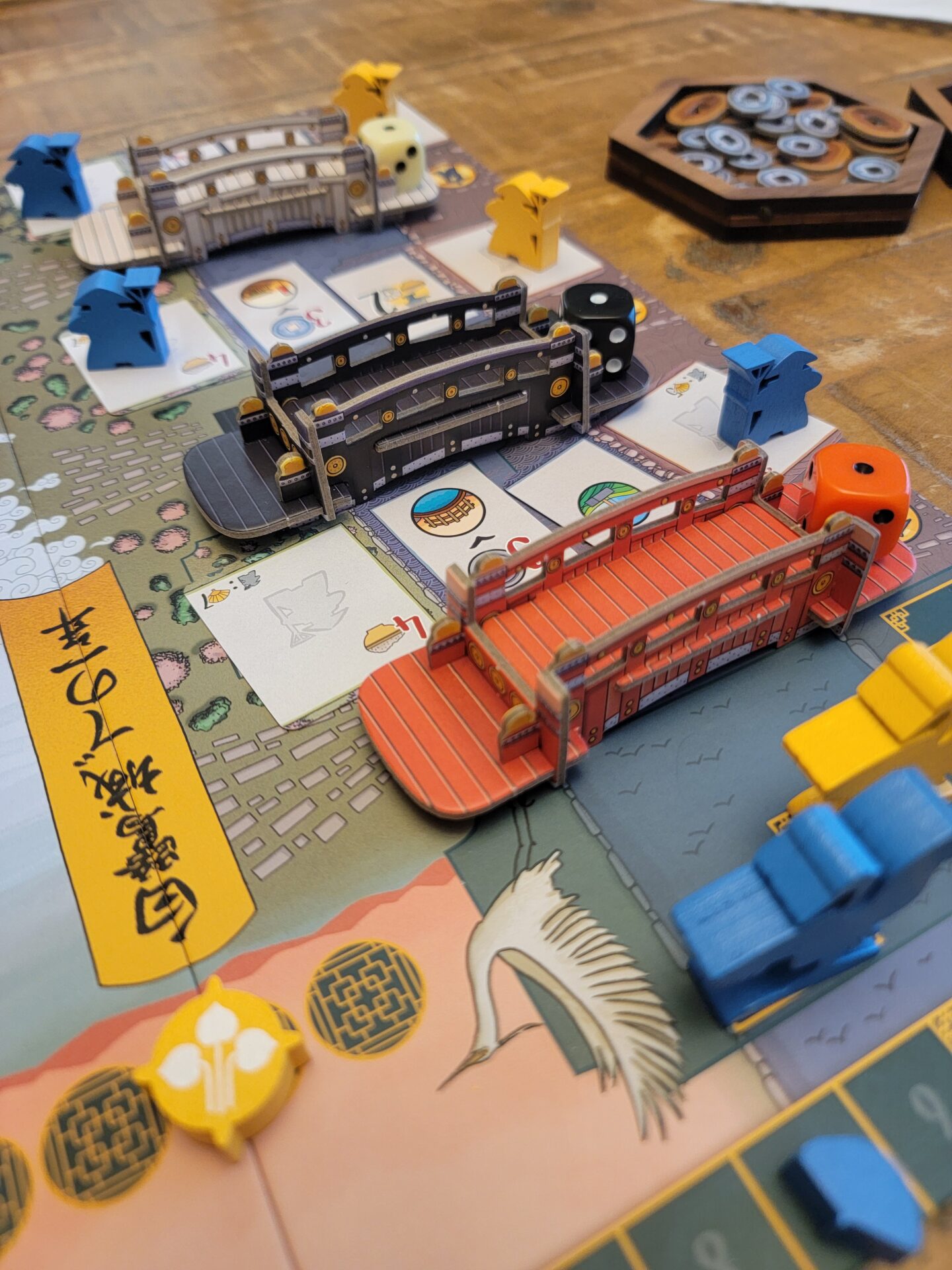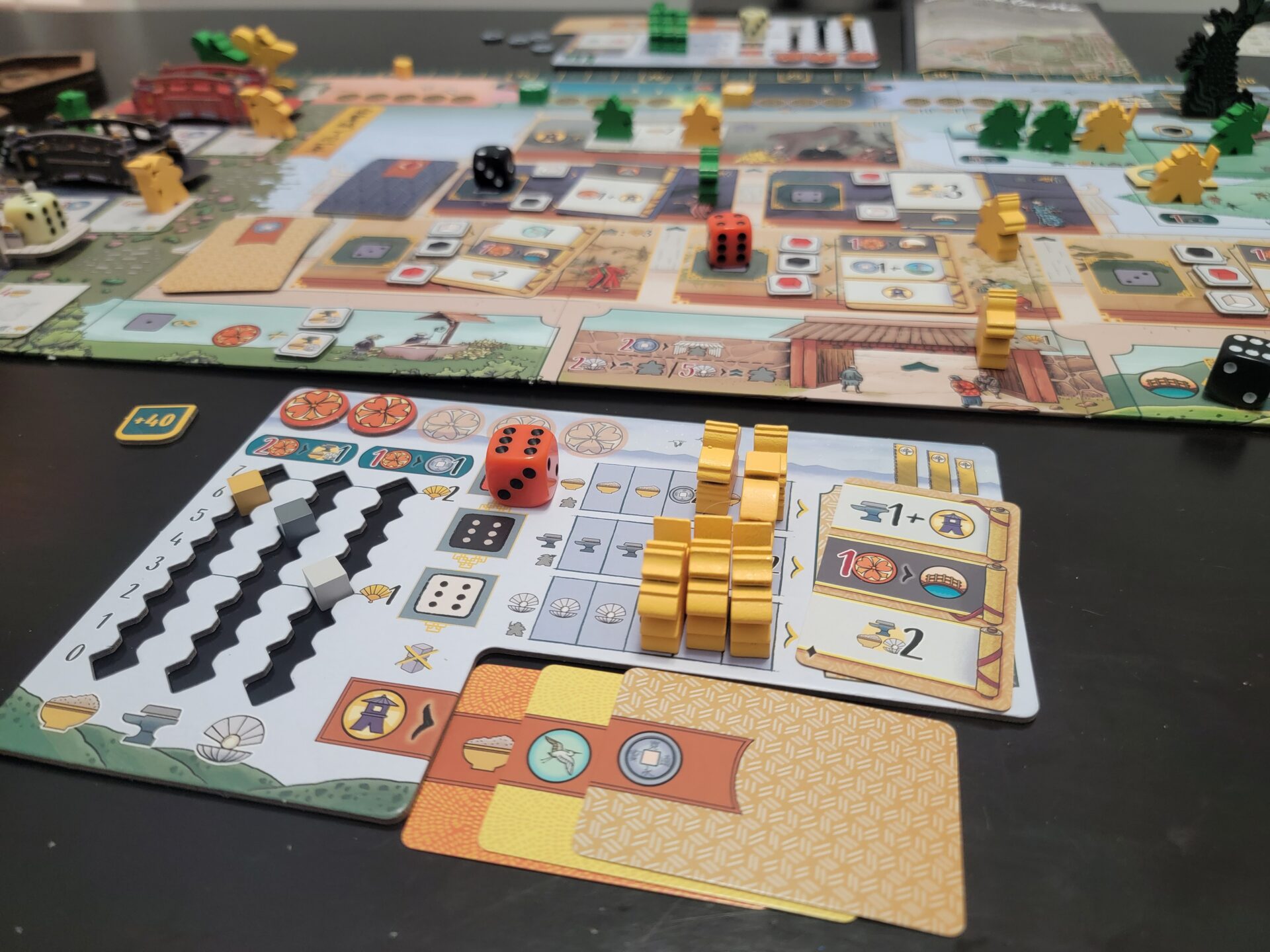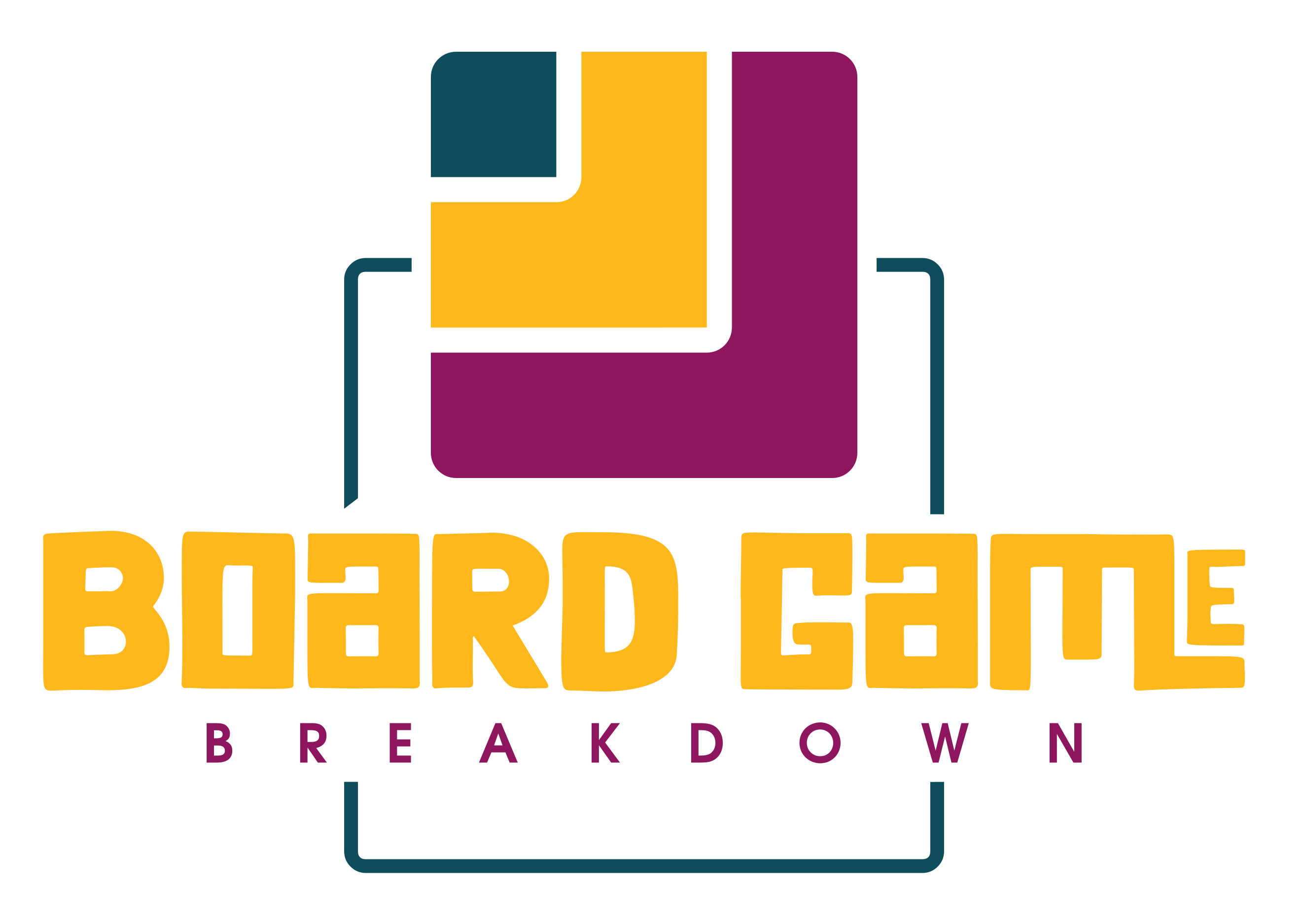
Name: The White Castle
Year of Release: 2023
Player Count: 1 – 4
Playing Time: 80 Minutes
Designer: Isra C. & Shei S.
Publisher: Devir
Primary Mechanisms: Dice Rolling, Action Drafting, Worker Placement with Dice Workers
Weight (According to BGG.com): 3.03
Overview
Sometimes there are games that I see a lot of coverage on, or maybe a multitude of social posts about, and the artwork worms its way into my brain but, for some unknown reason, I never explore anything else about the game. I’m probably missing out on a lot of great stuff this way, but I can’t help but gain a huge feeling of satisfaction when I stumble across one of these brain-worms in a local board gaming store. This is exactly what happened with The White Castle in early June of 2024.
I’m sure, if I would have looked into the game more, it would have been one of those that I knew I would like and I would have just ordered it online to have it show up at my door a few days later. But there is something magical about going through shelves of games in a store and stumbling across the box art and name that you’ve had stuck in your head for a while. Turning the box around and reading the description and getting your first real look at the board, it’s just an exciting feeling and much more fulfilling then just pushing the “Add to Cart” button. It’s also a nice feeling when you’re checking out and multiple employees say, “Oh, The White Castle! What a great game!”
So, were these employees correct in their exclamations of glee? Read on to find out!
Rulebook & Components
The first thing I noticed when picking the box off the shelf was it was a much smaller size than I expected but had a hefty weight to it. Opening it back at the hotel, as I was out of town at the time of purchase, I was greeted to about 9 different rule booklets, all printed in a different language. Ok, maybe it wasn’t 9, but it was at least 5. I recycled the ones I didn’t need and stuck with the one that I could read, as I could tell that it was going to be a puzzle fitting all the components back into the small-ish box.
The rulebook does its job and explains nicely both the multiplayer game and the solitaire variant. While the text in the book is great, I don’t love the quality of the pictures. There is something rather amateurish about them and they didn’t do the text any favors. This isn’t a huge gripe but as I played my first game, I did find myself staring at some of the pictures and thinking, “what in this picture aligns with what the text is trying to explain?”
Moving on to the components, I was wonderfully surprised by some of the thought put into them. First, there are the wonderful Bridges that players need to put together. These Bridges are only used to hold the Dice, and while you can play the game without them, they add a nice little pop! to the board. The second group of components that stuck out to me were the meeples, the Turn Order tokens, and the Round Tracker. Each of the four player colors is given three different meeples, with there being five of each type. These types include the Gardeners, holding some sort of rake-like instrument, the Warriors, equipped with their trust katanas, and the Courtiers, possibly with a fan strapped to their side but I might be way off here. Regardless, it’s a really nice touch that each meeple is styled differently and really helps to differentiate them as you start putting them out onto the board. The Turn Order tokens are styled after large Herons and look beautiful on the Turn Order Tracker while the Round Tracker is a stunning Koi (again, I might have the totally wrong fish here so please excuse me if I’m butchering this!) that rests on the upper corner of the board.

The last touch that I really love about the components is the way the players’ Domain Boards were designed. Instead of collecting individual resources in the game, players will move tiny colored cubes up one of the three tracks, Food, Iron, or Pearls. In games with similar features, I can’t stand how the cubes tend to slide around the board every time you might bump them. In The White Castle, the designers have made it so players will punch the actual track out of the board, creating a physical space for the cube to sit in and not move. The other components, including the Dice and the Cards, are of equal quality but let’s move on to the setup and gameplay!
Setup
The White Castle sets up easily enough but does include a bit of fiddly-ness when it comes to a few points. First, there are fifteen Die Tiles, with a colored cube (matching the Orange, Black, and White Dice) on one side, and a reward on the other. These have to be placed randomly into fifteen slots on the board and while it is random, there are some rules you have to follow to ensure that no space is filled with a single color. The second part of setup that I don’t love is placing the meeples in perfect lines in their specific places on the Domain Boards. If these spots were sunk in, like the resource tracks, it might not be as much of a drag, but they can easily fall over, knocking over the rest. I want to stress that these two complaints are fairly nit-picky, but they are two things that stand out negatively to me every time I set the game up.
Set up also includes putting Steward Cards and Diplomat Cards into their respective rooms in the Castle. These cards will have both light and dark scroll illustrations that line up with the aforementioned Die Tiles. There is also a single Daimyo Card selected to go into the top-most room of the Castle with the rest of these type of cards being placed back into the box. Players will also find two more categories of cards in the box: Plant Garden Cards and Stone Garden Cards. These piles will be shuffled independently and then three of each pile will be drawn and placed into their respective areas on the left side of the board.
The last of the cards to be put out is a number of Starting Resource Cards and Starting Action Cards that are equal to the number of players, plus one. These should be placed as pairs next to the game board for use at the end of setup.
Lastly, dice equal to the number players used for the Starting Cards, should be rolled and placed on the bridges matching the color of the dice. You’ll notice that the bridge is sectioned into three areas, the left-most area is reserved for the lowest die value, the right-most area is reserved for the highest die value, and all other die are placed into the middle, going from low to high in a left-to-right direction.

There are a few more easy steps to setup, but I’ll leave you to figure those out when playing. At this point, a turn order needs to be decided upon and the players’ Heron Tokens need to placed in the correct order on the board. Then in reverse turn order, players can choose a pair of the Starting Cards that were placed next to the board earlier in setup. After choosing, the player will collect any money or resources stated on the card, and then they will flip the card over and place it near the Lantern Icon on their game board. The Starting Action Card can also be placed into the necessary space on the players’ individual Domain Board. At this point, the game is afoot!

Gameplay
One of the traits of The White Castle that immediately stands out when playing is that the game only lasts a total of three rounds and in each round, players will only be technically taking three actions. We’ll get back to why I say “technically” later but for right now, just keep in mind that every turn needs to be as efficient and productive as possible. There is no time to waste any turns or actions in The White Castle.
The main way of triggering actions in the game is by taking a die from one of the three Bridges and then placing it on one of the Action Spaces on the board. There are three “rules” that are going to guide what actions you can take in this way, so let’s look at each one of these.
- Players can never select a die from the middle section of the bridge. They must select the die that is the lowest value (on the left side) or the highest value (on the right side.) Once a die is selected and placed on the board, the middle dice closest to the now-empty side, is slid into that spot. You might be wondering, “why would any player take the lowest value die?” Or maybe you’re not since I haven’t even explained the point of the die but regardless, everyone knows that lower values are always bad! The answer to that question is that if you are the player who takes the die on the left-most spot, you are allowed to trigger your Lantern Action. This action allows you to collect all resources that were listed on the back of the cards that you may (or may not) have placed at the bottom of your Domain Board.
- Remember those Die Tiles we placed out earlier, each with a different die color and that line up with the different scroll illustrations on the Steward and Diplomat Cards? The color of the action you want to take, must match up with the color of the die you have selected from the bridge. Considering these tiles were placed out randomly, some rooms can contain actions that can only be powered by a black or orange die, leaving players selecting white die out in the cold. I really like how this introduces some scarcity into the game and helps the dice to not “all be made equal.”
- Each of the Action Spaces where players will actually be placing die, has an illustration of a die value on it. This value is going to drive the cost players pay, or the rewards players will gain, from using these Action Spaces. If a player places a dice on a spot that is a lower value than what is printed, that player must make up the difference by paying coins to the bank. Inversely, if players place a die of a higher value on a space, they are allowed to gain the difference in coins from the bank. In a 3-or-4-player game, this gets even more interesting as players can place one of their die on top of a die that is already occupying a space. The same rule applies as far as the coins are concerned, but this opens up a larger selection of action spaces when there are more players. In a 1-or-2-player game, only one die can occupy each space.
Once the dice has been placed, the player triggers the action that’s die tile color matches the color of the die placed. There are a multitude of actions, such as gaining any of the three resources (food, iron, and pearls) or moving forward on the Passage of Time Track, but I want to focus on the big three that allow the player to move their meeples from their domain board to the main board. First, players can move Gardeners onto one of the six garden cards beneath the bridges. The Gardeners earn points at the end of the game but also allow players to trigger an extra action at round end if there are still dice left on the bridge above the card. Players are limited in only being able to have one Gardener on a card per game.

Secondly, players can pay silver coins to move a Courtier to the castle gate, and additionally, can spend pearls to send these Courtiers up either one level or two in the castle. As the Courtiers rise in the castle, they give the players extra card to add to their Domain board and score more and more points the higher they go. When a Courtier moves to a new room, the player can activate one of the White Scroll Actions for free and then they remove that card from the room. This card will then replace their current Action Card on their Domain Board, with the used Action Card being flipped over and placed in the player’s Lantern Row. This makes the Courtiers very powerful as they open up new actions for the players as well as strengthening the resources they’ll obtain from taking the Lantern Action.
Lastly, players can spend iron to put a Samurai meeple into one of the three yards to the right of the board. Each time a Samurai is placed, the player gains the bonus listed, or two bonuses if the Samurai was placed in the yard that costs five iron. Unlike the Gardeners, players can put any number of Samurais into any yard throughout the game. Samurais gain points based on the yard they are in multiplied by the number of courtiers in the castle, so it pays off to concentrate on both meeples if possible.

Players will take turns placing die until each player has taken a total of three turns. At the end of a round, players will take a look at the Passage of Time Track and see which players’ marker is in the lead. This marker is moved during the game by taking an action represented by a flying Heron in various places on the board. The Turn Order markers are rearranged to match the Passage of Time Track, awarding the leader of the Passage of Time Track to get first dibs when the dice are re-rolled for the next round. This is also when players get to activate their Gardeners if they were lucky enough to be placed below a bridge that still has dice housed on it. The second and third round play out identically to the first, except in the last round, players will not activate their Gardeners. The player with the most Clan Points at the end of the game wins.
Solo Comments
The White Castle comes packaged with instructions on how to play the game in a solo mode. Almost nothing about the player’s turn is changed from the description I’ve laid out above but there is an AI card deck that controls the rival clan’s decisions. For more information, check out our solo specific full-length How to Play video here or the four minute BURST overview video here over on YouTube.

Conclusion
The White Castle has been a surprise hit in our household, with my wife and I playing it six times before we reverted back to any of our old standards. With only three rounds, and three turns in each round, players will need to be efficient as possible with each decision they make. I have noticed that this can cause some analysis paralysis as players want to eek out every combo they can, but I wouldn’t say it has any higher a chance of AP than the average modern board game on the market. If you’re a fan of dice-or-worker-placement games that have a lot of depth to them, I suggest you give The White Castle a play or two whenever you get the chance!
Rating
Ratings are based on 5 main criteria: rulebook, setup, components, art & graphic design, and gameplay. The first 4 criteria are rated 1 to 5 and the gameplay is rated 1 to 10. These scores culminate in an “overall satisfaction” score that is rated from 1 to 10. If the reviewed game has both a solo and multiplayer mode, I have assigned scores separately to give context to which mode we enjoy more.
Links
As an Amazon Associate I earn from qualifying purchases.
Amazon: Amazon.com: The White Castle Board Game : Toys & Games

